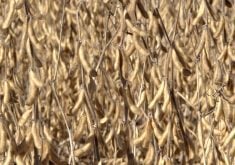CNS Canada — Dry conditions in southern areas of Saskatchewan and Alberta are limiting winter cereal seeding so far, as farmers wait for rain.
But that’s not the best strategy, according to Cordon Geisam, the southern Saskatchewan and southeastern Alberta territorial manager for FP Genetics, a Regina-based seed company that deals in fall rye hybrids.
Farmers who wait for rain before seeding may be letting opportunity pass them by, he said. “If you want a field of dreams, it doesn’t take much moisture for a winter cereal to germinate and grow.
Read Also

CBOT Weekly: Watching for Chinese soybean purchases
As activity at the Chicago Board of Trade shifts into holiday mode through the New Year, independent analyst Terry Reilly pointed to three things to watch over the next few weeks.
“If you wait for a moisture event, the moisture you are waiting for, by the time you can get on the field to do the work to put it in there, you’ve already lost most of the moisture.”
Geisam said he’s seen little winter cereal seeding in the parched dry south and he expects overall seeded area to decline, particularly for fall rye.
Growers who choose to go with a winter cereal could make out fairly well with prices in eight to 12 months, he said, because inventories will likely be substantially smaller then.
Paul Thoroughgood, of Ducks Unlimited and the Western Winter Wheat Initiative group, which has agronomists in several locations across Western Canada, echoed Geisam’s sentiments.
Producers in the chronically dry areas of the southern Prairies, in the brown and dark brown soil zones, are moving slowly with winter cereals seeding, he said.
Rain predicted for late this week and parts of next week has not yet materialized, he said. If it does come, he expects to see a flourish of farmer activity getting winter wheat in the ground.
Further north in the black soil zones, especially in areas of central Alberta and northeastern Saskatchewan, winter wheat seeding has been strong, with emergence already happening.
Overall, he said, winter wheat area may surprise some people. “I’m hopeful that we’ll see maybe a slight bump in winter wheat acreage.”
During the past few years, winter wheat has seen several factors claw back the yields it once enjoyed. In fall of 2016 about 1.5 million acres of winter wheat was seeded for harvest in 2017, which was well below the 2.2 million seeded only four years earlier.
Thoroughgood attributes the decline to better yielding spring wheats such as Prosper and Faller, which may have stolen winter wheat acres, particularly in such areas as Manitoba’s Red River Valley.
Soybeans have also replaced canola acres in a lot of areas and many growers followed canola crops with winter wheat in their rotations, he said. With soybeans being a much later maturing crop, it is more difficult to seed winter cereals following soybeans.
Manitoba Agricultural Services Corp., the provincial crop insurer, estimated Manitoba soybean area at 2.298 million acres this year.
‘Frustrated’
Another factor discouraging farmers from seeding winter wheat is price, he said — or more accurately, the price difference between Canada and the U.S.
“I bet I have received 20 phone calls during harvest from frustrated producers,” he said.
Prices offered for milling grade winter wheat are regularly $1 per bushel less in Canada than in the U.S.
Grain merchants tell him that the U.S. has done better at capturing markets for medium-quality wheat, he said, while Canada has primarily focused on markets for the highest quality wheats.
As well, he said, grain handlers tell him they want to ship goods out in 100-car unit trains to be as efficient and cost-effective as possible and it is difficult to find enough winter wheat to put together a shipment that large.
Thoroughgood pointed out the Catch-22 of the situation, in which grain handlers can’t get enough winter wheat to maximize efficiencies, which drives the price down. Yet because the price is down, fewer producers grow it, which makes it more difficult to gain the volumes necessary to maximize efficiencies.
He referred to an instance where he was trying to move winter wheat off his farm earlier this autumn and the best Canadian prices he found were in the low $4 per bushel range for milling and in the mid-$5 per bushel from hog plants.
“The quality of the winter wheat crop we took off was tremendous and to see the milling market that heavily discounted — it’s discouraging.”
According to Statistics Canada estimates, Manitoba farmers seeded about 140,000 acres in winter wheat last fall, Saskatchewan growers seeded 265,000 acres and Alberta growers seeded 130,000.
— Terry Fries writes for Commodity News Service Canada, a Winnipeg company specializing in grain and commodity market reporting. Follow CNS Canada at @CNSCanada on Twitter.















